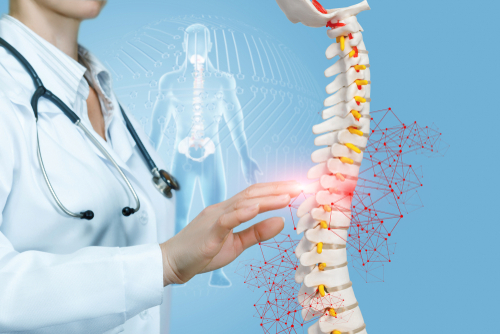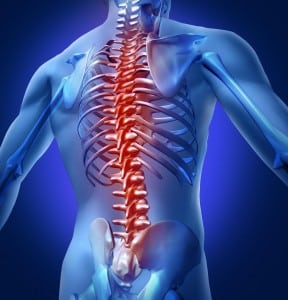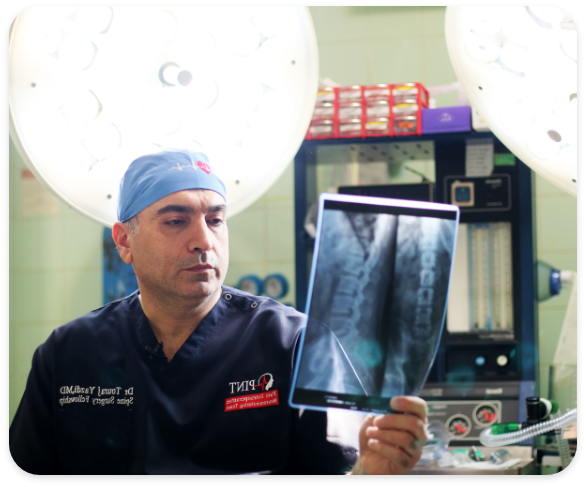Spinal surgery involves the treatment of a wide range of spinal diseases that may require surgery; These include lumbar disc herniation, osteoarthritis, vertebral frustration, infections and tumors, deviations, and fractures of the spine. Of course, this does not mean that the treatment of all these diseases is purely surgical; In fact, non-surgical treatments such as medications, braces, physical therapies such as physiotherapy and hydrotherapy, acupuncture, and a variety of minimally invasive surgeries such as injections and nerve blocks, laser and spinal endoscopic surgeries are also included in this area.
When should surgical treatment of spinal diseases be performed?
۱. They have weakness or movement disorders in the hands or feet.
۲. Impaired urinary and fecal control.
۳. Examination reveals signs of severe pressure on the spinal cord and nerve roots and their damage.
Many spinal surgeries use metal prostheses to secure the vertebrae. Wherever there is instability, it is necessary to use these prostheses called “platinum”. However, not using platinum in a patient who has vertebral instability will cause his pain to continue and intensify the instability. Damage to the vertebrae adjacent to the surgical site, but there are many patients for whom the decision to use these prostheses is not so simple, and sometimes there is no definite agreement between different surgeons, and both decisions can be right.

Complications of spinal surgeries
Surgery is not risk-free, and spinal surgeries can not only be a complication but can sometimes be painful.
In general, complications of spinal surgery are more common in older patients, heavier and longer operations, platinum use, a history of diabetes and osteoporosis, malnutrition and smoking, malignancy, overweight, and inability to move.
Apart from site infection and bleeding and infection and pulmonary embolism that is common to all major surgeries, nerve damage in spinal surgery is an important complication of the operation.
Although the risk is greatly reduced today with the use of intraoperative neurological monitoring, it has never reached zero. Removing the disc from the nerve root, removing the tumor from near or inside the spinal cord, and inserting screws and platinum into the spine through which multiple nerves pass can certainly be associated with the risk of nerve damage.
The experience and skill of the surgeon, the use of modern tools and technologies such as neurological monitoring, and accuracy and patience during surgery can prevent this complication.
Common methods of spinal surgery
Several diseases can be treated with spinal surgery. These methods are discussed below.
۱- Discectomy or microdiscectomy
During this surgery, the intervertebral disc herniation is removed to relieve pressure on the compressed nerve. Microdiscectomy is one of the least invasive spinal surgeries.
۲- Laminectomy
In the course of this surgery, a thin bony plate behind the spine is called a “lamina”; Will be removed. This is done to increase the space between the spinal canal and reduce the pressure.
۳- Laminotomy
During this surgery, the part of the vertebral arch (lamina) that covers the spinal cord; Will be removed. Laminotomy removes less bone than a laminectomy. Both laminectomy and laminotomy are “decompression” surgeries. Usually, in “decompression” surgeries, the amount of compression of the spinal nerves is relieved by the tissue.
۴- Foraminotomy
In the course of this surgery, tissue or bone is formed that passes (neuroforamen) where the nerve roots branch out from the spinal cord and out of the spine; Will be removed.
۵- Disk replacement
In the process of this surgery, an artificial disc replaces the damaged disc. This method is used as an alternative to welding nuts.

Accurate diagnosis of the disease
Spine surgery focuses on repairing an anatomical lesion and is never ” heuristic.” For patients suffering from low back pain but for no apparent reason, spinal surgery is not recommended and conservative treatment is recommended. Diagnostic tests (such as MRI or discograms) are used to determine the cause of the pain.
Advice before spine surgery
When deciding on surgery, the role of the spine surgeon is to educate you and assist you in the decision-making process. Provides you with information on a wide range of options and what is technically possible, the difficulty and risk of the procedure, Describes its potential benefits. Therefore, it is important to choose a spine surgeon who will provide you with the correct information.
What should be done to control pain?
Proper management of pain after spine surgery can help you recover physically and mentally. In addition to pain medication, your doctor or hospital nurse can help control your pain a little. For example, using ice in the first 48 hours after surgery can be very helpful. In addition, after the first 48 hours, ice can be used after exercise to reduce activity-related discomfort. For more information, you can follow the care after spine surgery
Is scar tissue normal after surgery?
Scar tissue formation is part of the healing process after normal surgical intervention. Scar tissue has no nerve endings, so it is rarely painful. Instead, the main cause of pain is fibrous adhesion to the nerve root. Because scar tissue is so common after surgery, its role in postoperative pain is highly controversial.
If you have scar tissue after surgery, it is perfectly normal. However, if the pain persists after surgery, a thorough medical examination is needed to determine the cause of the pain.
Rehabilitation programs
You need to follow the postoperative rehabilitation program carefully. Proper physiotherapy, stretching exercises, and lifestyle changes (for example, quitting smoking) will significantly speed up your recovery process and reduce the risk of recurrent pain.
Sources
https://www.mayoclinic.org/tests-procedures/spinal-fusion/about/pac-20384523
https://medlineplus.gov/ency/patientinstructions/000313.htm
https://journals.lww.com/jspinaldisorders/pages/default.aspx

